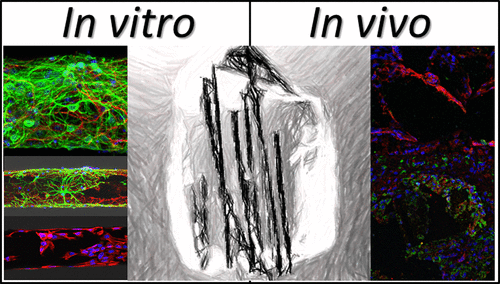Our official English website, www.x-mol.net, welcomes your feedback! (Note: you will need to create a separate account there.)
Favorable Biological Responses of Neural Cells and Tissue Interacting with Graphene Oxide Microfibers
ACS Omega ( IF 4.1 ) Pub Date : 2017-11-21 00:00:00 , DOI: 10.1021/acsomega.7b01354 Ankor González-Mayorga 1 , Elisa López-Dolado 1, 2 , María C Gutiérrez 3 , Jorge E Collazos-Castro 1 , M Luisa Ferrer 3 , Francisco Del Monte 3 , María C Serrano 2, 3
ACS Omega ( IF 4.1 ) Pub Date : 2017-11-21 00:00:00 , DOI: 10.1021/acsomega.7b01354 Ankor González-Mayorga 1 , Elisa López-Dolado 1, 2 , María C Gutiérrez 3 , Jorge E Collazos-Castro 1 , M Luisa Ferrer 3 , Francisco Del Monte 3 , María C Serrano 2, 3
Affiliation

|
Neural tissue engineering approaches show increasing promise for the treatment of neural diseases including spinal cord injury, for which an efficient therapy is still missing. Encouraged by both positive findings on the interaction of carbon nanomaterials such as graphene with neural components and the necessity of more efficient guidance structures for neural repair, we herein study the potential of reduced graphene oxide (rGO) microfibers as substrates for neural growth in the injured central neural tissue. Compact, bendable, and conductive fibers are obtained. When coated with neural adhesive molecules (poly-l-lysine and N-cadherin), these microfibers behave as supportive substrates of highly interconnected cultures composed of neurons and glial cells for up to 21 days. Synaptic contacts close to rGO are identified. Interestingly, the colonization by meningeal fibroblasts is dramatically hindered by N-cadherin coating. Finally, in vivo studies reveal the feasible implantation of these rGO microfibers as a guidance platform in the injured rat spinal cord, without evident signs of subacute local toxicity. These positive findings boost further investigation at longer implantation times to prove the utility of these substrates as components of advanced therapies for enhancing repair in the damaged central neural tissue including the injured spinal cord.
中文翻译:

神经细胞和组织与氧化石墨烯微纤维相互作用产生良好的生物反应
神经组织工程方法在治疗包括脊髓损伤在内的神经疾病方面显示出越来越大的前景,但目前仍缺乏有效的治疗方法。受到石墨烯等碳纳米材料与神经成分相互作用的积极发现以及更有效的神经修复引导结构的必要性的鼓舞,我们在此研究了还原氧化石墨烯(rGO)微纤维作为受伤神经生长基质的潜力中枢神经组织。获得致密、可弯曲、导电的纤维。当涂有神经粘附分子(聚-L-赖氨酸和N-钙粘蛋白)时,这些微纤维可以充当由神经元和神经胶质细胞组成的高度互连的培养物的支持基质,持续时间长达21天。识别出靠近 rGO 的突触接触。有趣的是,N-钙粘蛋白涂层极大地阻碍了脑膜成纤维细胞的定植。最后,体内研究揭示了这些 rGO 微纤维作为受伤大鼠脊髓中的引导平台的可行植入,且没有明显的亚急性局部毒性迹象。这些积极的发现促进了在更长植入时间内的进一步研究,以证明这些基质作为先进疗法的组成部分的效用,以增强受损中枢神经组织(包括受损脊髓)的修复。
更新日期:2017-11-21
中文翻译:

神经细胞和组织与氧化石墨烯微纤维相互作用产生良好的生物反应
神经组织工程方法在治疗包括脊髓损伤在内的神经疾病方面显示出越来越大的前景,但目前仍缺乏有效的治疗方法。受到石墨烯等碳纳米材料与神经成分相互作用的积极发现以及更有效的神经修复引导结构的必要性的鼓舞,我们在此研究了还原氧化石墨烯(rGO)微纤维作为受伤神经生长基质的潜力中枢神经组织。获得致密、可弯曲、导电的纤维。当涂有神经粘附分子(聚-L-赖氨酸和N-钙粘蛋白)时,这些微纤维可以充当由神经元和神经胶质细胞组成的高度互连的培养物的支持基质,持续时间长达21天。识别出靠近 rGO 的突触接触。有趣的是,N-钙粘蛋白涂层极大地阻碍了脑膜成纤维细胞的定植。最后,体内研究揭示了这些 rGO 微纤维作为受伤大鼠脊髓中的引导平台的可行植入,且没有明显的亚急性局部毒性迹象。这些积极的发现促进了在更长植入时间内的进一步研究,以证明这些基质作为先进疗法的组成部分的效用,以增强受损中枢神经组织(包括受损脊髓)的修复。


























 京公网安备 11010802027423号
京公网安备 11010802027423号